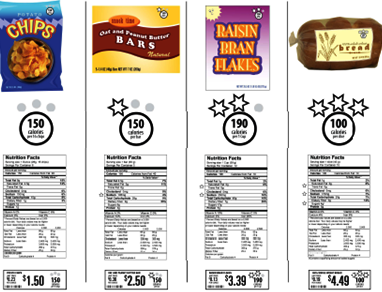The Institute of Medicine (IOM) just released its second report on front-of-package (FOP) labeling. It tells FDA to allow only four items in any front-of-package evaluation scheme:
- Calories
- Saturated and trans fat
- Sodium
- Sugars
To display this, the IOM committee recommends a point system based on levels of saturated and trans fats, sodium, and sugars for evaluating food products. The points are to be indicated with check marks or stars. Here is an example of how stars might be used to indicate products that qualify for zero, one, two, or three points.

I’m guessing that anything this clear and understandable will elicit storms of protest.
Recall that food companies have been setting their own nutrition criteria for evaluating their very own products and identifying the “better-for-you” or “more nutritious” products with special front-of-package logos. By company standards, many of their products qualify for the logos.
To deal with the multiplicity and absurdity of such schemes, the FDA asked the IOM to take a look at the various FOP logos that were out there and recommend how to clean up the mess. The first IOM report said the FDA should allow FOP labels to state only calories, saturated and trans fat, and sodium, but not sugars (this last was a mistake, I thought).
But—while the FDA was waiting for the IOM to produce its next report, the Grocery Manufacturers Association (GMA) and Food Marketing Institute (FMI) jumped the gun. Their preemptive logo included “positive” nutrients such as vitamins and fiber along with the “negatives.” This scheme is already in use on food packages.
The IOM committee was faced with an impossibly difficult task: to come up with a front-of-package scheme that would reduce the overall nutritional quality of processed foods to the sum of a few key factors.
Given strong industry marketing pressures to retain front-of-package labels—and the lack of an option to remove them altogether—the committee did the best it could with an inherently bad idea.
Why a bad idea? FOP labels are a tool for selling, not buying. They make highly processed foods look healthier, whether or not they really are.
And whether slightly better-for-you processed foods assessed by this method will help anyone to make better food choices and to be healthier remains open questions.
Nevertheless, the IOM proposal is a huge improvement over what food companies are now doing. I consider it courageous.
Why courageous? Because the scheme makes it so easy to distinguish products that qualify for the various point levels.
For example, here are some products that qualify for stars:
- Toasted oat cereal
- Oatmeal, instant
- Milk, 1% fat
- Yogurt, plain nonfat
- Salad dressing, light
- Orange juice, 100%
- Grape juice, 100%
- Kidney beans, canned
- Peanut butter
- Tomato soup, “healthy”
- Tomatoes, canned
Examples of products that do not qualify:
- Animal crackers
- Graham crackers
- Breakfast bar
- Sweetened toasted oat cereal
- Oatmeal, instant with fruit, nuts
- Chocolate milk
- Yogurt, sweetened
I can’t wait to see the GMA and FMI press release on this report.
And the FDA must now take this report under consideration to begin its interminable rulemaking process.
Why, you might ask, does any of this matter? Aren’t questions about what food companies put on package labels basically trivial? Don’t FOP label fights divert attention from other, more important food issues?
Maybe, but I see this as a test of the FDA’s authority to regulate and set limits on any kind of food industry behavior. If the FDA cannot mandate a label that might help consumers choose healthier food options or refuse to permit labels that mislead consumers, it means the public has little recourse against any kind of corporate power.
I think this matters, and I’ll bet food companies do too.
And now, sit back and watch the lobbying begin!
That did not take long: Here’s the GMA press release—fairly tame all things considered:
The Institute of Medicine’s Committee on Examination of Front-of-Package Nutrition Rating Systems and Symbols report adds a perspective to the national dialogue about front-of-pack nutrition labeling. In the meantime, food and beverage companies have developed a real-world program that delivers real value to real consumers in real time.
Consumers have told us that they want simple and easy to use information and that they should be trusted to make decisions for themselves and their families. The most effective programs are those that consumers embrace, and consumers have said repeatedly that they want to make their own judgments, rather than have government tell them what they should and should not eat. That is the guiding principle of Facts Up Front, and why we have concerns about the untested, interpretive approach suggested by the IOM committee.
My translation: Consumers prefer to have the food industry’s “Facts Up Front” tell them what to eat? I don’t think so.
.








